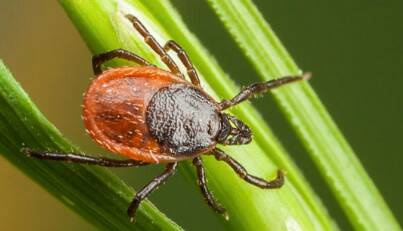
Tick, tick, boom… tick populations explode around the state.
Ticks are back, and they’re here to stay.
Entomology Director and Senior Medical Entomologist at the Indiana Department of Health Lee Green said we now have six ticks in Indiana of medical importance, including two that have been newly discovered within the last decade.
Indiana’s tick species are Blacklegged, Lone Star, Gulf Coast, American Dog, Brown Dog and Asian Longhorned ticks.
The Gulf Coast Tick is originally from the west coast of the United States, and the Asian Longhorned Tick is originally from Japan. The Asian Longhorned Tick was first discovered in Indiana last year.
“We are conducting active surveillance on the Gulf Coast Tick’s reach,” Green said. “We are monitoring your area, because we have found them in surrounding counties like Monroe County. The Asian Longhorn was first discovered in New Jersey in 2017 and is now found in 20 states, including Indiana.”
Green said that Asian Longhorn Ticks are not a huge vector for humans because they do not have an affinity for people, but they are a concern for agriculture and livestock.
According to the U.S. Centers for Disease Control and Prevention’s website (www.cdc.gov/ticks/about/index.html) ticks can spread bacteria, viruses and parasites resulting in human diseases. Tickborne illnesses include Bourbon virus, Colorado Tick fever, Lyme disease, Rocky Mountain spotted fever, Southern Tick-Associated Rash illness and Soft Tick Relapsing fever.
Green told the Democrat that Alpha-Gal is not on that list because it is not a pathogen, but an immune response. The Department of Health is spreading awareness about the response as another reason to watch out for tick bites.
“Alpha-Gal occurs in non-primate-mammalian meat,” Green said. “It is a response to the saliva of a Lone Star Tick. Everyone reacts differently to it, but many have a reaction after they eat meat or animal byproducts like milk.”
Green said that some people are able to micro-dose meat and animal byproducts slowly over time to acclimate their bodies, but because it is so new long-term reactions are still being studied.
Environmental Health Specialist at the Brown County Health Department Jennifer Heller said that people should be concerned about a tick bite if they start developing symptoms of tick-related illness.
“These can vary depending on what they have contracted,” Heller said. “Refer to the CDC publication ‘tickborne diseases of the United States’, a reference manual for health care providers. Then you can look up the individual diseases, treatments and what ticks carry.”
Common symptoms for tickborne illnesses include fever, chills, distinctive rashes, headaches, fatigue and muscle aches.
Green said that he does not recommend any of the wives’ tales about removing a tick with a match or nail polish.
“Pathogens are transmitted through saliva,” Green said. “The most important thing is to get the tick out of you. Grab the tick as close to the skin as you can, preferably with tweezers or a tick removal device. Once you do remove, sometimes it’s a good idea to save it in case you begin to show a reaction so you can take the tick to your doctor and they will know what illnesses to test you for. When a tick feeds, they cement to you. What people typically see left after they remove a tick is the cement, sometimes the mouth can get stuck to that because it is barbed. The important part is getting out the salivary glands.”
Green said that it takes time for ticks to trasmit disease because they have to be attached.
“Do a tick check when you come back in from playing outside, hiking or camping,” Green said. “Just take a shower and check your body for ticks. EPA regulated repellant actually works. Permethrin is a great pesticide that can treat clothing. You apply it to clothing and allow to dry. Depending on the type you buy, some can be good after a few washes. That is what our entire team does when we go out to search for ticks.”
Since 2017, there have been 12 confirmed cases of Lyme disease in Brown County from adult tick infectivity, according to the Indiana Department of Health.

